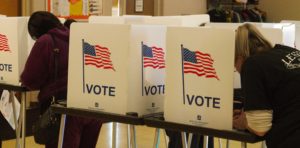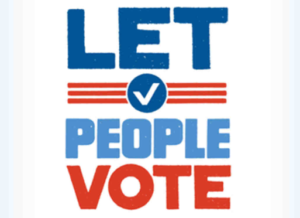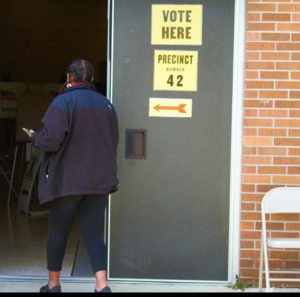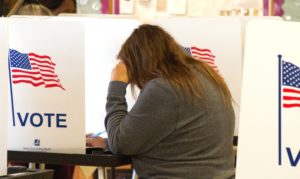By Paul Rozycki
In the United States we elect over 500,000 individuals to office. Every election year, the voters choose who will be their governors, senators, state representatives, mayors, city council members, judges, county commissioners, school board members, township clerks, drain commissioners, and perhaps an occasional dog-catcher here and there.
And all of those individuals are chosen based on one cardinal rule. Whoever gets the most votes wins.
With one exception. The President of the United States.

Voters in Ward 4 on election day 2022. (Photo by Tom Travis)
We elect the president by way of the Electoral College, a complex system that often confuses voters and has rarely worked as intended. Perhaps the most surprising thing about the Electoral College is that most of the time it has elected the individual who got the most votes.
But not always. On five separate occasions, in 1824, 1877, 1888, 2000 and 2016, the Electoral College chose the candidate who lost the public vote as president of the United States. In 2000 Al Gore had about 500,000 more votes than George W. Bush, but the Electoral College vote went to Bush. In 2016, Hillary Clinton had about 3 million more votes than Donald Trump but Trump carried the Electoral College.
History
The Electoral College has a curious history and has been modified several times from its original intent. Originally electors were to be local leaders and were expected to exercise their own independent judgement on who they thought should be president. Voters were to choose the electors and let the electors pick the president. With the possible exception of the elections of George Washington, that fell by the wayside early in our history.
Winner take all
With the creation of political parties in the early1800s, (which the founding fathers thought was a bad idea) the electors began to automatically cast their votes for their party. Gradually most states began to adopt the ‘winner take all’ policy, where whoever got the most votes from a state got all of the electoral votes. Today all states, except Maine and Nebraska, use the ‘winner take all’ approach. That ‘winner take all’ policy has been the main reason we have elected the second place candidate on five occasions. It’s possible to build up a huge majority of votes in some large population states (like California or New York) and lose others by a narrow margin, giving the other candidate an electoral margin.
Reasons in favor
Those who favor the current system say that, while there are flaws with the current system, it does give a large voice to the smaller states who might otherwise be overlooked in a national election. There is some truth to that. For example, the smallest population state, Wyoming, has about 570,000 people, about half the population of Oakland County Michigan, which has more than 1,200,000 residents. Yet, Wyoming gets three electoral votes, equal to its representation in the U.S. Congress. Similar numbers are true for other small population states. That gives Wyoming a bit more clout that it might otherwise have. But it also means that in Wyoming there are about 144,000 people per electoral vote, while in a state like Florida it takes 536,000 people to equal one vote.

Voters lined up outside City Hall during the November 2020 election. (Photo by Paul Rozycki)
Others feel that the existence of the Electoral College makes a complex national recount less likely, as might have been the case in 1960 when Kennedy barely won Illinois to win the presidency. In many elections the electoral vote expands the margin for the winning candidate.
Problems with the Electoral College
While the Electoral College may give a little extra clout to small states, it also means that many states are ignored during a presidential campaign. Because of the ‘winner take all’ rule, whoever gets the most votes in a state gets all the electoral votes. So that forces candidates to focus heavily on the ‘tossup states’ that could go either way. Win Michigan by one vote and you get all 15 electoral votes. Win Pennsylvania or Georgia by one vote and you get all of their electoral votes. In 2020 the great majority of all campaign events were held in 6 states. Nearly 65 percent of voters live in states where the candidates rarely visit.
In addition, for states that strongly support one party there is no reason for either party to campaign there. Wyoming and West Virginia are strongly Republican states. Why should a Republican bother campaigning there? If they get 51 percent of the vote, or 99 percent they will get all the electoral votes. For Democrats the same is true. Why bother to campaign there? If they get 49 percent of the vote or 1 percent, they will get zero electoral votes. For states that typically vote Democratic like California or Massachusetts the pattern prevails in reverse.

That pattern also limits a voter’s impact on the national election. If you are a Democratic voter in Wyoming or West Virginia your vote won’t help your presidential candidate at all. If you are a Republican voter in California or Massachusetts the same is true. A popular vote election would mean that everyone’s vote would play an equal role in deciding the winner, whether they are in Wyoming, West Virginia, Massachusetts, California, or anywhere else.
Turnout
One other problem with the Electoral College is that the electoral votes are equal to the number of members of Congress a state has—two senators and the number of U.S. House members in a state. The smallest population states have three electoral votes and the largest (California) has 54. Michigan currently has 15. The problem is that the voter turnout doesn’t change that number. If only 1 percent vote in California they decide all 54 electoral votes. If 5.5 million vote, more than 70 percent, in Michigan, as they did in 2020, they decide how our 15 electoral vote are cast.
Faithless electors
While the electors are pledged to support their party’s candidate if they win, they technically do have the right to vote any way they want. That was the original intent of the Electoral College. In recent elections there have been ‘faithless electors’ who voted for someone other than their party’s candidate. In 2016, John Kasich, Bernie Sanders, Colin Powell, Ron Paul, and Faith Spotted Eagle all received electoral votes for president. There have been 165 ‘faithless electors’ in over the years. So far, no election has been changed because of a faithless elector, and 33 states have passed laws to prevent it from happening, but the possibility remains.
January 6 and the ‘fake electors’
The events around the January 6th insurrection and the attempts to overturn the 2020 election with ‘fake electors’ and proposed actions by the vice president demonstrate one additional risk of the current electoral system. As part of the plot to overturn the 2020 election ‘fake electors’ were put forward in seven key states, including Michigan. The hope was that they would somehow replace the genuine electors and give Trump the victory.
How to fix the system
Over the years a number of plans have been put forward to address the problems with the Electoral College. A September 2020 Gallup poll showed that 61 percent of Americans were in favor of abolishing the Electoral College, an increase of 12 points from 2016.

Flint voter entering Durant-Tuuri Mott School on election day 2022. (Photo by Tom Travis)
Constitutional Amendment
The most straight forward way to fix the problem would be simply to amend the Constitution, abolish the Electoral College, and have the president elected by a popular vote. But the amendment process is long and difficult, normally requiring support of two-thirds of both houses of Congress and three-fourths (38) of the states. It’s not easy, and most observers feel that an amendment would have little chance of success at this time.
The Proportional Plan
Some argue that the states should divide their votes in proportion to the popular vote in that state. For example, if a candidate got 60 percent of the vote, they would get 60 percent of the electoral votes, not 100 percent as is the case in most states today. The losing candidate would get 40 percent of the electoral votes. Though this plan would eliminate the ‘winner take all’ aspect of the Electoral College, it might end up throwing elections into the House if no one got the required 270 votes, especially if third parties picked up some electoral votes.
The District Plan
Since the number of electoral votes that each state gets is equal to the number of representatives in Congress, some have supported a plan which would give electoral votes to whoever won each Congressional district in a state. The candidate with the most votes statewide would get the two extra votes for the U.S. Senators. Nebraska and Maine use a version of the district plan. However, some projections of the district plan indicate that it would have as many failures as the current system, and would be subject to gerrymandered election districts.
The National Popular Vote Compact
The proposal that Michigan voters are likely to see on the ballot next year is the National Popular Vote Compact. Quite simply this plan would give all of Michigan’s electoral votes to the candidate with the most votes nationwide. So far 15 states and the District of Columbia, representing 195 electors, have supported the idea, and Michigan could be the next one. It keeps the Electoral College, retains a state role in presidential elections, but gives the votes to the popular vote winner.

A voter in the fourth ward at St. Andrews Episcopal Church. (Photo by Tom Travis)
What is notable in these divided times is that the proposal is supported by the past chairs of both the Michigan Democratic and Republican parties. Both former Republican Party Chair Saul Anuzis, and former Democratic Party Chair Mark Brewer, are working together to support the proposal. If supported by enough states, with 270 or more electoral votes, it would not eliminate the Electoral College, but would assure that the winner of any presidential election received the most votes from the public.
It almost got on the ballot in 2022. In the months to come look for petitions to place it on the ballot in 2024.
Maybe it is time to ‘unelect the electors’ or at least change the way we elect presidents.

EVM Political commentator Paul Rozycki
EVM political commentator and board president Paul Rozycki can be reached at paul.rozycki@mcc.edu.


You must be logged in to post a comment.